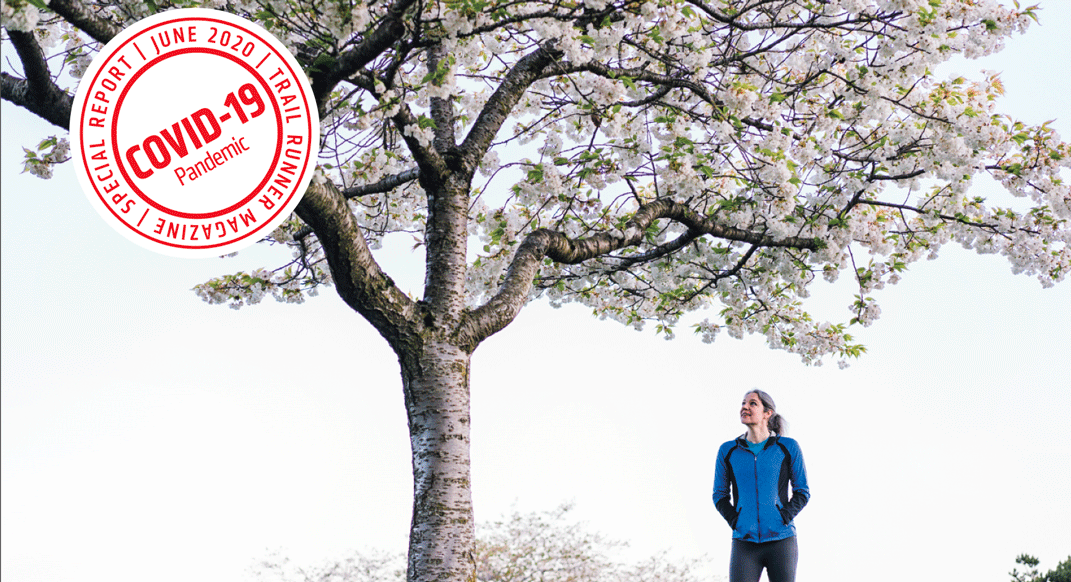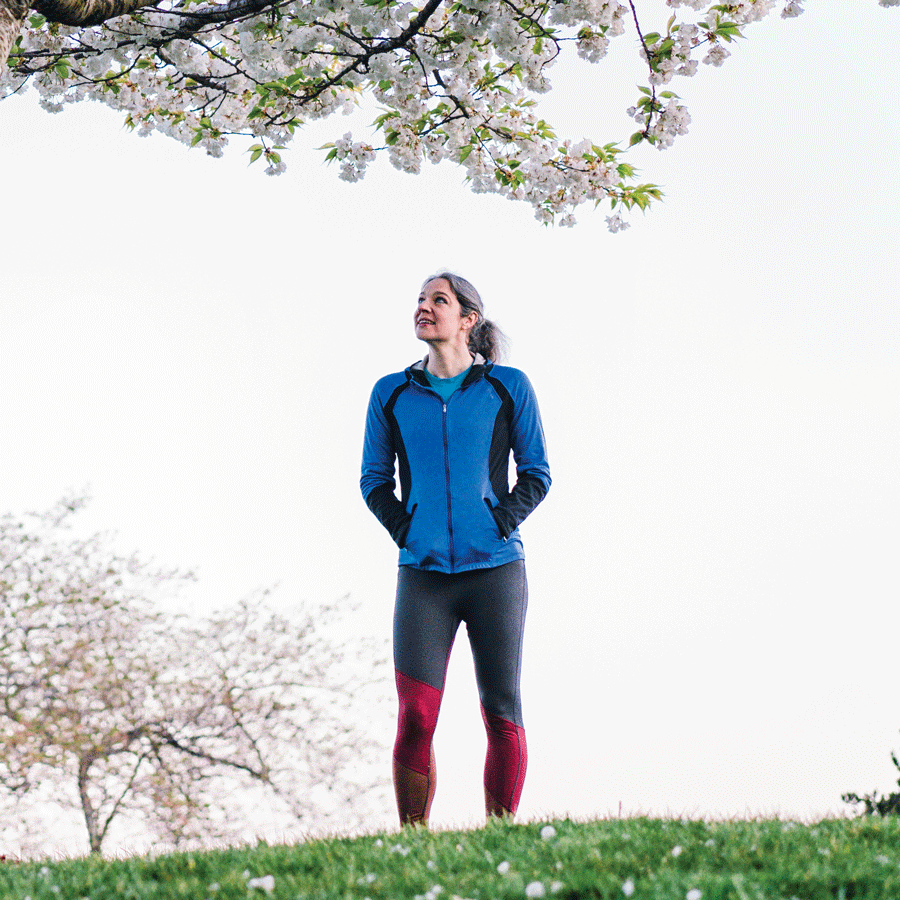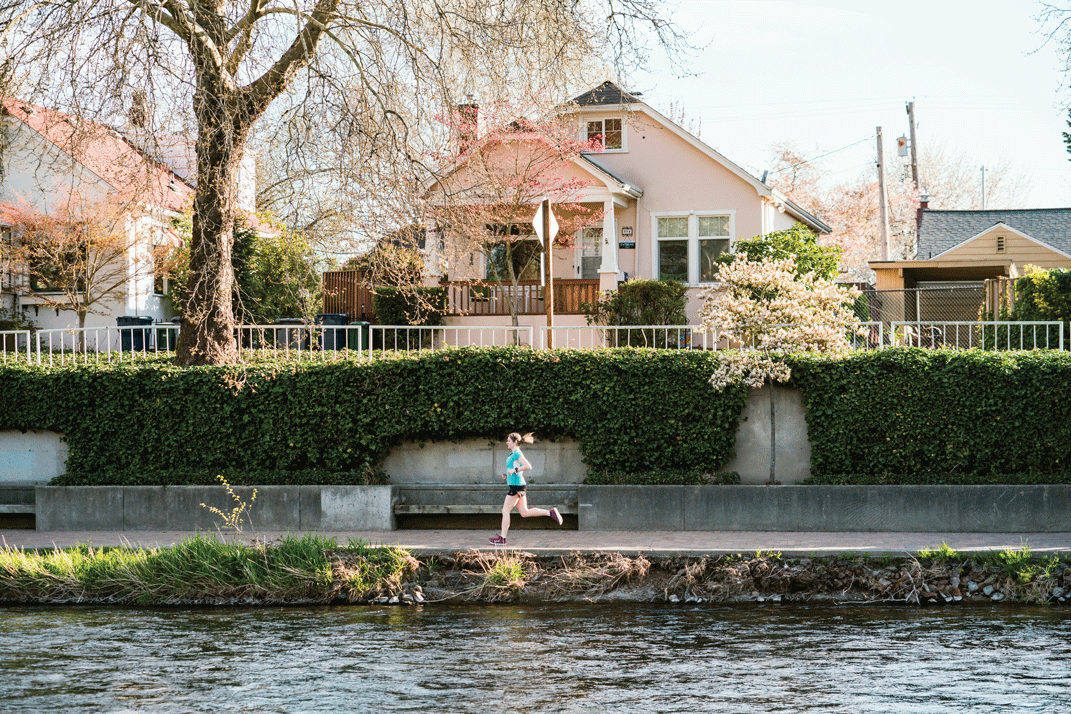Small Delights

The streets are empty. There are no stoplights to wait for, because no cars are going anywhere. My route—the same one I run every morning these days—takes me through the deserted downtown corridor of Renton, Washington, on the outskirts of south Seattle. I run past boarded-up windows, playgrounds lassoed in yellow caution tape, once-bustling cafes emptied of their chairs and tables.
My pace is slow, my breathing easy; I’m not training for anything. 2020 will be the first year in nearly two decades that I haven’t run a race.
I’d planned it this way, though.
Last fall, I’d decided to take the coming year off from racing—in part because I sometimes worried that I’d devoted too much time and energy to the endeavor, and in part because my husband, George, and I wanted to have a child, and I never wanted pregnancy to be a reason to feel resentful of giving up something that I loved. So, I figured, best to give it up first, temporarily, on my own accord.
At the time, I felt excited about embracing a different pace of life in 2020. Fewer miles, less traveling, no more 4 a.m. alarm clocks to jam training in before work. More sleeping. More easy jogging. More reading and writing and cooking.
I expected to make this massive shift in a relatively lonesome vacuum while so many of my friends continued their running lives as usual.
But, of course, that’s not exactly what happened.
As an anxious person, I had many fears about being pregnant—fears about the potential for miscarriage, for postpartum depression, for debilitating pelvic-floor injuries. The uncertainty of whether I’d ever enjoy the same freedom to run in the mountains that I had for the past decade.
Though enthusiastic about motherhood, I’d long felt ambivalent about pregnancy. Running and mental health had always been inextricably linked for me. As an anxious person, I had many fears about being pregnant—fears about the potential for miscarriage, for postpartum depression, for debilitating pelvic-floor injuries. The uncertainty of whether I’d ever enjoy the same freedom to run in the mountains that I had for the past decade.
If I had to, could I live without the comforting routine that training and racing brought me? Would the joy of a baby be strong enough to carry me through any potential losses? I hoped so. Imagined mama-me, or even imagined pregnant-me, was far more resilient than regular-old-me.
I gathered courage where I could find it. Echoing in my head were the words of essayist Mary Schmich, immortalized by Baz Luhrmann’s “Sunscreen Song” adaptation that had crested the radio billboards when I was in grade school: Enjoy your body. Use it every way you can. Don’t be afraid of it or of what other people think of it. It’s the greatest instrument you’ll ever own.
When you’re in your early 30s, older runners are quick to proffer advice: “Oh, you’re just hitting your ultrarunning prime! Don’t take these next few years for granted.”
But running ultras was only one of the symphonies my body could be an instrument in, I told myself. There were others, for which I was also in my prime. I took Schmich’s words literally: Use it every way you can. She didn’t say, Use it only one way, really well.
George already had three kids from his first marriage. I’d thought becoming a stepmom might do all the scratching my maternal itch required—but their presence in my life was a gift that only stoked my enthusiasm about motherhood further.
Once we decided for sure to try to have a child together, I felt dizzy with excitement. It never crossed my mind that getting pregnant in the first place might be an endurance event of its own, filled with uncertainty about whether I’d ever see the finish line.
Months passed. I didn’t get pregnant. Friends did. Coworkers did. Baby bumps seemed to appear everywhere. One cycle, my period didn’t come on time, and my hopes soared—only to be crushed anew when, instead of a regular period, I bled for 12 days straight and sobbed in George’s arms because I thought my body might not be capable of carrying a healthy baby.

I grew up in Kansas but left the Midwest after college, moving to the Pacific Northwest in a quest to bring more mountains into my daily life. Years later, returning to visit my hometown with adult eyes, I was amazed by how much smaller everything seemed—the hill I used to consider a mountain; the neighborhood creek that had once seemed a mystical river; the flat, suburban bike path on which I’d baptized my 15-year-old self into the world of running, but which now paled in comparison to the ribbons of singletrack in the high alpine kingdoms I’d since visited.
Once upon a time, my old running route on the bike path had seemed an extraordinary expanse. How dazzling it had all been—cornfields, wooded patches, graffitied highway overpasses, even the manicured business park in which my out-and-back route terminated.
Running gave me a sense of control and calm at a time in my life when I had very little of either. It furnished the gift of freedom to venture where I pleased, whenever I wanted, on my own two feet.
Running gave me a sense of control and calm at a time in my life when I had very little of either. It furnished the gift of freedom to venture where I pleased, whenever I wanted, on my own two feet. On any given day, I might catch sight of a turtle basking on a sunny log in the creek, or discover an old rope swing, half-hidden in the trees, which led me to wonder who might have put it there, and imagine whose hands and feet had clung to it over the years or even generations. My expeditions through the suburbs sent me home exhilarated and delirious with joy.
None of those childhood artifacts—the hill, the creek, the bike path—had actually gotten smaller in my absence, of course. What happened was that I’d gone out into the world and gotten spoiled by vaster wildernesses.
That, or I’d simply gotten older, and blinder. Farther from the magic of seeing the world through the eyes of a child. With life comes exposure to new experiences, and with those comes the inevitability of comparison—and comparison has a sneaky way of rubbing the sheen right off of once-awesome delights.

My morning run in Renton takes me on a meandering mile before I reach the Cedar River. Two months earlier, relentless rains had caused it to flood many feet deep over the adjacent brick trail, and bury whole swaths of land. I’d stood on a bridge over the raging river while entire trees were swept downstream at alarming speed. Watching the earth fall apart beneath my feet, I couldn’t help but dwell on my simultaneous anxieties that (a) our town might disappear underwater altogether, and (b) I was never going to get pregnant.
But soon, the water receded. It left thin lines of washed up leaves and driftwood and other debris on the grassy banks where it had once risen to. As my feet touched the soil that, weeks earlier, had been underwater, I thought of how dire things had seemed at the height of the flood. Then, abruptly, how everything was OK again.
Hadn’t every race, long run or hard workout I’d ever done already taught me that lesson, again and again? Everything is all right in the end, and if it’s not all right, it’s not the end. Keep calm and carry on.
The next pregnancy test I took came back positive.
In February, I began keeping a journal of letters written to our future child. I filled it with giddy observations of the world around me. A hummingbird hovering outside our window. The snow-dusted summit of our favorite local mountain. A tiny purple crocus bursting through the soil.
“The wealth of a day in wildness is measured in increments of awe,” the conservationist and author Terry Tempest Williams wrote. Suddenly, my days were rich with awe at all the things I couldn’t wait for our little nugget to experience for the first time.
“The wealth of a day in wildness is measured in increments of awe,” the conservationist and author Terry Tempest Williams wrote. Suddenly, my days were rich with awe at all the things I couldn’t wait for our little nugget to experience for the first time.
The journal became a veritable book of delights—a term I borrowed from the poet Ross Gay, who published a collection of lyric essays reflecting on small “delights” observed during his daily life. In the book’s preface, he wrote, “It didn’t take me long to learn that the discipline or practice of writing these essays occasioned a kind of delight radar. Or maybe it was more like the development of a delight muscle. Something that implies that the more you study delight, the more delight there is to study.”
As my body threw its energy toward building a tiny human, my running pace slowed considerably. The leisurely miles helped me notice more things along the way. As the baby grew bigger, my delight muscle grew stronger.
Nothing elicited more enthusiasm in my journal than the sight of a bald eagle soaring overhead. More than three decades ago, I’d been born into a world in which bald eagles were still considered an endangered species. As a child, I’d lamented that I would probably never see one in the wild before they became extinct. It had never occurred to my anxious mind that things might go the other way—that bald eagles would rebound and become a common (though no less delightful) sight in my adult life.
That floodwaters would recede.
That my body might be capable of doing what once seemed impossible.
In my mid-20s, I’d moved from Seattle to a small town in Colorado for a job with Trail Runner. Writing opportunities led me to run singletrack all over the world—Iceland, the Canary Islands, the Alps, the Andes. Each place I ran increased the wildness quotient and fostered a hunger inside of me for more. More miles, harder challenges, more magnificent landscapes.
I loved the summers in Colorado, but grew impatient in the other seasons, when snow fell, storms pummeled the earth, trails closed for elk calving, mud season arrived. I’d moved there in part to live closer to the mountains, so if I couldn’t run in them for half the year, why was I there at all?
I voiced my frustrations once to George, who at the time, was still just a friend back in Washington with whom I kept in touch by email. He suggested I get a camera and, during the off-season, use it to find beauty in the little things around me—the bark on a tree, a dragonfly’s wings—rather than dwelling on the absence of epic summer adventures and soaring alpine vistas.
Back then, his advice felt unattainable. How could small delights ever fill the void of grand ones?
I also recognized that some people—children and parents, among them—possessed a different kind of wisdom about where pockets of joy could be unearthed. I didn’t know anyone who loved running in the mountains more than George—yet in a decade of trail running, the only singletrack he’d really ever run was in Washington State. No international races, no epic trail-running vacations. He was a family man who stuck close to home and who ran—often, the same two or three local trails, over and over again—for no reason other than he loved to run in the woods.
The purity of his devotion reminded me of an essay published in Adventure Journal and written by Martin J. Smith, titled “Home Stream: The joy of fishing the same stretch of water over and over.” In it, Smith wrote, “Life’s treasures are all around us, within reach of those who have the time and patience simply to notice them. I intend to live here and fish until I die, and I sincerely believe I’ll die happy—even if I never again fish anywhere else. For me, repetition has become an act of exquisite memorization. Just as I find simple comfort in the faces of my wife and our children, I find it, too, in a perfect tongue of water that spills into a deep pool in the upper section not far from my back door.”
Eventually I moved back to Washington, fell in love with George, married him and found myself ready, at last, to face my fears about how pregnancy might alter my relationship with running. In the fall of 2019, I declared on my blog that I was going to take 2020 off from racing. I wrote: “Maybe what I really need is a year of getting lost again with George on silly, simple adventures in our backyard mountains. Our home stream.”
Then our backyard mountains closed. With the arrival of March came news of the first COVID-19 deaths on U.S. soil, right here in Washington State. Our governor issued stay-in-place orders, trailheads were shuttered and overworked search-and-rescue personnel and hospital workers begged people to stop going into the mountains. I let go of the idea that I would be able to hike or run trails, however gently, throughout my pregnancy—a tiny sacrifice compared to what this pandemic is taking from society at large.
Our governor issued stay-in-place orders, trailheads were shuttered and overworked search-and-rescue personnel and hospital workers begged people to stop going into the mountains. I let go of the idea that I would be able to hike or run trails, however gently, throughout my pregnancy—a tiny sacrifice compared to what this pandemic is taking from society at large.
So, our home stream had gotten smaller. At least we still had one.
My morning jogs through Renton follow the same five-mile route every day—part residential neighborhood, part urban environs, part narrow greenbelt along the river, sandwiched between the Renton Municipal Airport and the sprawling Boeing factory complex that comprises much of Renton’s now-furloughed workforce and crashing economy. I run past dozens of jetliners sitting untouched on the tarmac.
The morning air is quiet. A golden eagle with immense, spackled wings scans the river below for fish. A rabbit cowers in the tall blades of grass, keeping a watchful eye on me as I pass. A family of baby ducks scurries toward the water’s edge.
In addition to the wildlife, I get to know the four or five human “regulars” on my route—the neighbors who, like me, require some fresh air each morning. We smile and nod at one another, the way I used to give a knowing nod to fellow trail runners in the mountains. With at least six feet of space between us, we call out, “Good morning!” and I am reminded that though we are all apart this season, we are still going through it together.
My route also takes me past the intersection where Renton’s first hospital once sat, built in 1911. Today, there is a brewery in its place, a fitness studio, a set of fancy apartments—but back then, the hospital housed 15 beds where, just over a century ago, local residents infected with the Spanish influenza went to be treated. Then, like now, people wore masks in public, gatherings were banned, and schools were closed indefinitely.
By World War II, that hospital had been replaced by a bigger facility located elsewhere along my route—only to be replaced 20 years later by an even bigger hospital where, today, doctors and nurses are working around the clock to save the lives of people with severe cases of Covid-19. It’s also where, this fall, universe willing, our baby will take its first breath of air in this world.
Life and death—the most fundamental of cycles in this world, though certainly not the only one. Floods and droughts. Scarcity and abundance. Sickness and health. Humans have weathered such seasons before, and we will weather them again.
Keep calm and carry on.
Certainly, this five-mile loop is a far cry from the mountains in Washington that I’ve grown accustomed to running. But these quiet morning adventures around Renton bring me back to the bike path in Kansas where my love affair with running began. In the face of uncertainty, the act of putting one foot in front of another is a reassuring one. Deliberate observation begets joy. Just like the child growing inside of me who will soon get to experience our world’s magic for the first time, these jogs invite me to revisit the reverie I once felt amidst simple delights.
I reach the southern shore of Lake Washington just in time to see the predawn light paint the Olympic Mountains on the horizon with the fire of alpenglow. Cherry blossoms drift down from a tree above, carpeting the grass at my feet with hundreds of pale pink petals. As if on cue, two bald eagles circle overhead.
With my hand on my belly, I take one last look at the mountains—they’re not going anywhere, I remind myself—and turn around to run home.